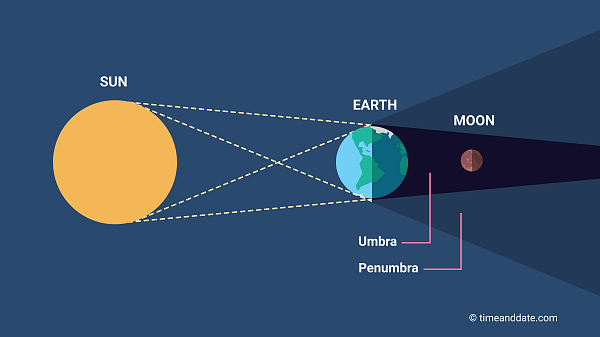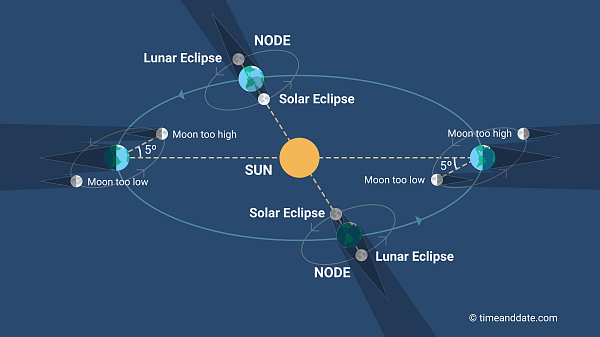What Is a Total Lunar Eclipse?
A total lunar eclipse takes place when the Earth comes between the Sun and the Moon and its shadow covers the Moon. Eclipse watchers can see the Moon turn red when the eclipse reaches totality.

Next Total Lunar Eclipse: Fri, Mar 14, 2025 … See animation
Next Eclipse: Partial Lunar Eclipse – Wed, Sep 18, 2024 … See animation


Earth casting its shadow on the Moon.
timeanddate.com
March 24-25, 2024: Micro Moon and penumbral lunar eclipse
Paired Together
Total eclipses of the Moon happen at Full Moon when the Sun, Earth, and Moon are aligned to form a line. The astronomical term for this type of alignment is syzygy, which comes from the Greek word for being paired together.
Earth Blocks the Sunlight
The Moon does not have its own light but shines because its surface reflects the Sun's rays. During a total lunar eclipse, the Earth comes between the Sun and the Moon and blocks any direct sunlight from reaching the Moon. The Sun casts the Earth's shadow on the Moon's surface.
Earth's Three Shadows
Earth's shadow can be divided into three parts:
- Umbra - the darker, central part.
- Penumbra - the outer part.
- Antumbra - the partly shaded area beyond the umbra.
During a total lunar eclipse, Earth's umbra completely covers the Moon.
Sun, Earth, and Moon Aligned
For a lunar eclipse to occur, the Sun, Earth, and Moon must be roughly aligned in a line. Otherwise, the Earth cannot cast a shadow on the Moon's surface and an eclipse cannot take place.
When the Sun, Earth, and Moon come together in a straight line, a total lunar eclipse takes place. When the three bodies are aligned in a way that the Moon is partly covered by the Earth's umbra, a partial lunar eclipse is the result. On the other hand, if only the outer part of Earth's shadow covers the Moon, a penumbral lunar eclipse takes place.
Earth's umbra extends into space far beyond the orbit of the moon. This means that Earth's antumbra plays no role in lunar eclipses.
Only at Full Moon


Lunar nodes are the locations where the Moon crosses the Earth's orbital plane.
Total lunar eclipses happen only when:
- It is Full Moon.
- At the same time, the Moon is at (or very near) a lunar node, so the Sun, the Moon, and the Earth are aligned in a straight (or nearly straight) line.
Why don't we see a lunar eclipse every month if a Full Moon is needed for a total lunar eclipse?
This is because the plane of the Moon's orbital path around Earth is inclined at an angle of 5° to Earth's orbital plane around the Sun, also known as the ecliptic. The points where the two orbital planes meet are called lunar nodes. Lunar eclipses occur when a Full Moon happens near a lunar node.
The Moon Looks Red
Even though Earth blocks sunlight from directly reaching the surface of the Moon during a total lunar eclipse, the Moon is still visible to the naked eye. This is because Earth's atmosphere bends sunlight and indirectly lights up the Moon's surface.
When sunlight passes through the Earth's atmosphere, it gets refracted towards the Earth's surface, and part of it—the colors with shorter wavelengths—gets scattered and filtered out, while the rest, colors with longer wavelengths like orange and red, passes through the atmosphere. This light is once again refracted towards the surface of the fully eclipsed Moon, thus illuminating it in a reddish-orange glow. Because of this, a total lunar eclipse is sometimes colloquially called a Blood Moon.
Different Colored Eclipses
A lunar eclipse can also be yellow, orange, or brown in color. This is because different types of dust particles and clouds in Earth's atmosphere allow different wavelengths to reach the surface of the Moon.
Tetrads and Blood Moons
A series of four consecutive total lunar eclipses with no partial or penumbral lunar eclipses in between is called a lunar tetrad. In recent years, eclipses in a lunar tetrad have also been popularly called Blood Moons. This usage of the term has no technical or astronomical basis and it is thought that it has Biblical origins.
7 Stages of the Eclipse
A total lunar eclipse usually happens within a few hours. Totality can range anywhere from a few seconds to about 100 minutes. The July 26, 1953 total lunar eclipse had one of the longest periods of totality in the 20th century—100 minutes and 43 seconds.
There are 7 stages of a total lunar eclipse:
- Penumbral eclipse begins: This begins when the penumbral part of Earth's shadow starts moving over the Moon. This phase is not easily seen by the naked eye.
- Partial eclipse begins: Earth's umbra starts covering the Moon, making the eclipse more visible.
- Total eclipse begins: Earth's umbra completely covers the Moon and the Moon is red, brown, or yellow in color.
- Maximum eclipse: This is the middle of the total eclipse.
- Total eclipse ends: At this stage, Earth's umbra starts moving away from the Moon's surface.
- Partial eclipse ends: Earth's umbra completely leaves the Moon's surface.
- Penumbral eclipse ends: At this point, the eclipse ends and Earth's shadow completely moves away from the Moon.
The Moon's orientation in the sky depends on the observer's latitude. This means the eclipse will appear to play out in different directions depending on your location.
Where Can I See a Total Lunar Eclipse?
Almost everyone on the night side of Earth can see a total eclipse of the Moon. Because of this, most people have higher chances of seeing a total lunar eclipse than a total solar eclipse, even though both occur at similar intervals.
No Special Equipment Needed
Unlike solar eclipses, observing a total lunar eclipse does not require any special equipment. Lunar eclipses are safe to see with the naked and unaided eye.
How Often Do They Happen?
About 29% of all lunar eclipses are total lunar eclipses. On average, a total lunar eclipse can be seen from any given location every 2.5 years.




